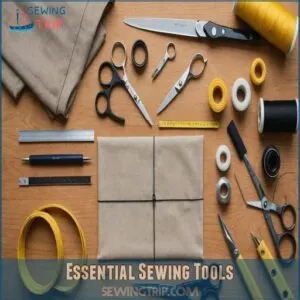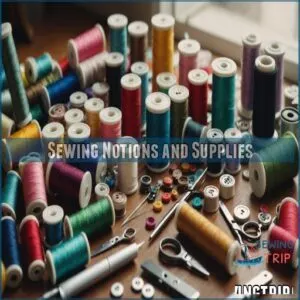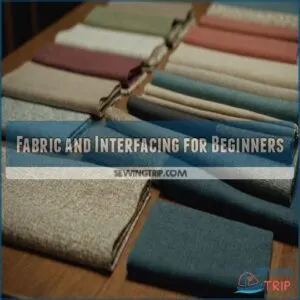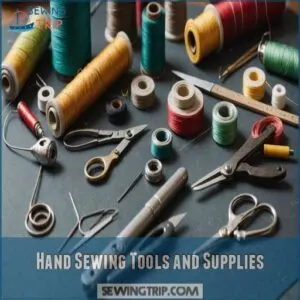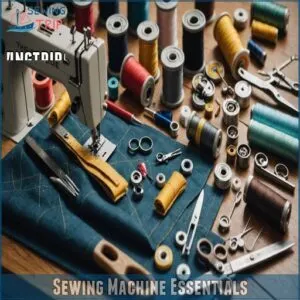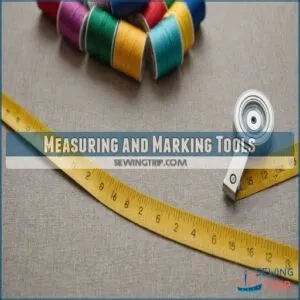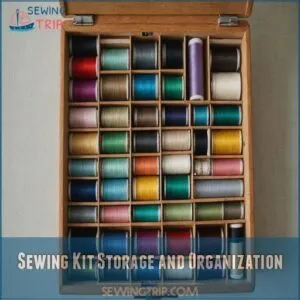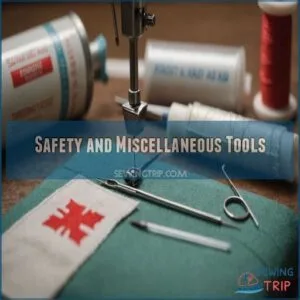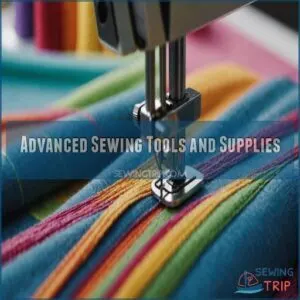This site is supported by our readers. We may earn a commission, at no cost to you, if you purchase through links.
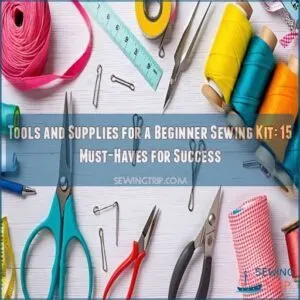 To kickstart your sewing journey, gather essential tools and supplies for your beginner sewing kit.
To kickstart your sewing journey, gather essential tools and supplies for your beginner sewing kit.
You’ll need a pair of sharp fabric scissors and pinking shears to prevent fraying.
Include a tape measure and a seam gauge for accuracy in your projects.
Add marking tools like tailor’s chalk or fabric markers, and don’t forget pins, pin cushions, or clips for securing fabric.
A selection of needles—both hand sewing and machine types—is vital, along with a few spools of thread in basic colors.
Round off your kit with a seam ripper for those occasional "uh-oh" moments.
Ready to stitch up a storm?
Table Of Contents
- Key Takeaways
- Essential Sewing Tools
- Sewing Notions and Supplies
- Fabric and Interfacing for Beginners
- Hand Sewing Tools and Supplies
- Sewing Machine Essentials
- Measuring and Marking Tools
- Sewing Kit Storage and Organization
- Safety and Miscellaneous Tools
- Advanced Sewing Tools and Supplies
- Building a Beginner Sewing Kit
- Frequently Asked Questions (FAQs)
- Conclusion
Key Takeaways
- Start your sewing kit with essential cutting tools like sharp fabric scissors and a seam ripper for precise work and easy corrections.
- Include measuring tools such as a tape measure and seam gauge for accuracy in your projects.
- Stock up on basic sewing supplies like needles, thread, and marking tools to ensure you’re prepared for a variety of tasks, including setting up your sewing machine with the right thread the machine properly. Stock up on basic sewing supplies like needles, thread, and marking tools to ensure you’re prepared for a variety of tasks.
- Organize your tools with a practical storage solution, like a sewing box or portable kit, to keep everything accessible and tidy.
Essential Sewing Tools
You’ll need essential sewing tools to start your journey as a seamstress.
From cutting tools like scissors and rotary cutters to measuring devices such as tape measures and rulers, these must-have items will set you up for sewing success.
Cutting Tools
The right cutting tools can make or break your sewing projects.
You’ll need a few essentials to slice through fabric like a pro:
- Sharp fabric scissors for precise cuts
- Rotary cutter for quick, straight lines
- Self-healing cutting mat to protect surfaces
- Pinking shears to prevent fraying edges
- Seam ripper for fixing mistakes
Remember, keep your blades sharp and handle with care.
Your fingers will thank you!
Measuring Tools
Now that you’ve got your cutting tools sorted, let’s focus on measuring accuracy.
You’ll need a trusty tape measure for those tricky curves and a transparent ruler for straight lines.
Don’t forget a seam gauge for precise hems and buttonholes.
These tools are your best friends for nailing those perfect fits.
Remember, in sewing, precision is key – measure twice, cut once!
Marking Tools
Marking tools are your secret weapon for precision sewing.
They’re essential for transferring pattern details and ensuring accurate stitching.
You’ll find a variety of options to suit different fabric types and projects:
- Tailor’s chalk for crisp, temporary lines
- Water-soluble pens for easy-to-remove marks
- Tracing wheels with carbon paper for intricate pattern transfers
Choose tools that complement your fabric and provide clear, removable marks.
With the right marking tools, you’ll nail those darts, pleats, and buttonholes like a pro.
Pins, Clips, and Pin Cushions
Say goodbye to pricked fingers! Pins, clips, and pincushions are your new best friends.
These handy tools hold fabric in place while you work your magic.
Let’s break down your options:
| Tool | Purpose |
|---|---|
| Glass-head pins | Heat-resistant for ironing |
| Quilting pins | Extra-long for thick fabrics |
| Wonder clips | No-hole alternative to pins |
| Magnetic pincushion | Quick pin pick-up and storage |
Choose the right combo, and you’ll be stitching like a pro in no time!
Thread and Needles
Thread and needles are the lifeblood of your sewing projects.
You’ll need a variety of thread types and needle sizes to tackle different fabrics and techniques.
For hand sewing, opt for sharp needles and sturdy thread.
Machine needles come in various sizes; match them to your fabric weight.
Don’t forget a needle threader—it’s a real eye-saver!
Keep a mix of polyester and cotton threads handy for versatility.
Sewing Notions and Supplies
Now that you’ve got your essential sewing tools, let’s talk about the little things that make a big difference: sewing notions and supplies.
These unsung heroes of your sewing kit can turn a good project into a great one.
You’ll want to stock up on pins and needles of various sizes – they’re like the salt and pepper of sewing.
Don’t forget to check out a thread assortment for different colors and types to match your projects.
Don’t forget a pincushion to keep them organized.
Seam rippers are lifesavers when you need a do-over, and scissors are a must for snipping.
Grab some marking tools like chalk or fabric pens to mark your designs.
Thread will cover most of your needs.
For those tricky fabrics, interfacing and stabilizers are your secret weapons.
And here’s a pro tip: invest in a small sewing kit for on-the-go fixes.
With these notions, you’ll be ready to tackle any project that comes your way.
Fabric and Interfacing for Beginners
You’ll need fabric and interfacing to bring your sewing projects to life.
These essential materials come in various weights and types,
allowing you to create everything from soft pillowcases to structured bags with the right foundation.
Choosing The Right Fabric
Having the right notions and supplies sets you up for success.
Let’s talk fabric – it’s the canvas of your sewing journey.
When choosing fabric, consider your project’s needs.
Cotton‘s great for beginners – it’s easy to work with and forgiving.
Quilting cotton, for instance, is perfect for simple projects.
Remember, different fabrics behave differently.
Start with something that won’t slip or stretch too much.
You’ll be stitching like a pro in no time!
Understanding Fabric Weight and Weave
Diving into fabric weight and weave can feel like unraveling a mystery, but it’s key to your sewing success.
Understanding these elements helps you choose the right fabric for your projects.
Here’s what you need to know:
- Lightweight fabrics (2-3 oz/yd²) like chiffon drape beautifully
- Medium-weight fabrics (4-7 oz/yd²) such as cotton are versatile
- Heavyweight fabrics (8+ oz/yd²) like denim offer structure
Weave
- Plain weave is simple and sturdy
- Twill weave creates diagonal lines and is durable
Interfacing and Batting for Specific Projects
While fabric choice is key, interfacing and batting are the unsung heroes of many sewing projects.
Interfacing adds structure to collars and cuffs, while batting gives quilts their cozy feel.
You’ll find fusible and sew-in interfacing types, each suited for different fabrics, but when substituting interfacing, consider interfacing fabric alternatives that mimic the properties of traditional interfacing.
For knits, opt for stretch interfacing to maintain flexibility.
When choosing batting, the lighter option is better suited for wall hangings, while the heavier option is best for bed quilts.
Hand Sewing Tools and Supplies
You’ll need a well-organized collection of hand sewing tools to tackle any project with confidence, including quality needles, sturdy scissors, and a reliable seam ripper.
Even with a sewing machine at your disposal, these essential hand tools will help you handle intricate details and make quick repairs with precision.
Needles and Thread for Hand Sewing
Your needles and thread are like trusty companions in your sewing journey.
Start with an assorted pack of hand-sewing needles, including sharps for everyday use and betweens for detailed work.
Choose polyester all-purpose thread for durability, keeping in mind that different threads work best for specific stitches, such as the running stitch technique.
Here are three key tips for success:
- Match needle size to fabric weight
- Test thread strength
- Keep needles sorted by type and size
Remember, quality tools make learning easier.
Thimbles and Thimble Pads
Traditional metal thimbles protect your fingers from needle pricks, but they aren’t your only option.
Leather thimbles offer flexibility, while silicone versions provide excellent grip.
For maximum comfort, try adhesive thimble pads that stick directly to your fingertip.
Keep multiple sizes handy since different projects require various levels of protection.
A well-fitted thimble makes hand-stitching feel natural and effortless.
Scissors and Seam Rippers
Sharp tools make a world of difference.
Keep fabric scissors separate from regular scissors to maintain their precision – you’ll want them razor-sharp for clean cuts through any fabric.
A seam ripper becomes your best friend when mistakes happen, letting you undo stitches without damaging the fabric.
Pro tip: replace your seam ripper annually to maintain its effectiveness.
Sewing Machine Essentials
You’ll need specific tools and supplies to keep your sewing machine running smoothly, including those from top reliable sewing machine brands like Singer and Brother, including machine needles, bobbins, and specialized feet for different stitches.
Your sewing machine’s manual will guide you through the essential accessories, but you’ll want to start with a Brother XR9550 or similar beginner-friendly model that includes an automatic needle threader and drop-in bobbin system.
Choosing The Right Sewing Machine
Now that you’ve mastered hand stitching, let’s power up your sewing game.
Modern beginner-friendly machines like the Brother XR9550 offer the perfect balance of features and simplicity.
You’ll want built-in stitches, automatic threading, and adjustable speed control.
Don’t feel pressured to spend big – a reliable $200-300 machine will serve you well while you’re learning the ropes.
Understanding Sewing Machine Parts
Getting familiar with your sewing machine’s core parts will make you feel like a seasoned pro in no time.
The bobbin system sits beneath the needle plate, working in harmony with the upper thread to create perfect stitches.
You’ll find the tension control dial near the top, while different foot types attach to the presser foot holder, letting you tackle various sewing techniques with confidence.
Basic Sewing Machine Accessories
Along with your trusty sewing machine, you’ll need essential accessories to keep things running smoothly.
Stock up on extra bobbins for quick thread changes, and keep various presser feet handy for different techniques.
Don’t forget replacement needles for different fabric types, a responsive foot pedal for speed control, and sewing machine oil to maintain your machine’s performance.
Measuring and Marking Tools
You’ll need reliable measuring and marking tools to create perfectly fitted garments and guarantee your projects come together with professional precision.
Your sewing kit should include a flexible tape measure, clear ruler, and fabric markers that’ll help you transfer pattern markings and make accurate measurements every time.
Tape Measures and Seam Gauges
With your sewing machine set up, let’s talk about precision. Tape measures and seam gauges are your trusty sidekicks for accurate measurements. You’ll use these tools constantly, from sizing patterns to marking hems.
A flexible tape measure wraps around curves, while a seam gauge helps with those pesky short measurements.
- Tape measure types: Retractable vs. non-retractable
- Seam gauge uses: Hem depths, seam allowances, buttonholes
- Accuracy tips: Keep tape measure taut, align seam gauge precisely
- Marking techniques: Use pins or chalk with measuring tools
Rulers and Quilting Squares
When you start sewing, rulers and quilting squares become your trusty sidekicks.
These measuring tools come in various sizes, from pocket-friendly 6-inch rulers to hefty 24-inch behemoths.
Transparent quilting rulers, marked with precise grids, help you nail those perfect cuts.
For patchwork precision, grab a square ruler – it’s a game-changer for trimming blocks.
With a variety of specialized tools like seam gauges and curves, you can guarantee accuracy in your sewing projects.
Remember, accuracy is key, so invest in quality tools to keep your projects on point.
Marking Chalk and Fabric Markers
Marking chalk and fabric markers are your sewing project’s secret weapons.
You’ll use these tools to transfer pattern markings and create guidelines.
Chalk comes in various forms, from wedges to powder, and brushes away easily.
Water-soluble fabric markers offer precision but require testing.
For dark fabrics, opt for white marking pencils.
Remember, the right marking technique can make or break your project’s accuracy.
Sewing Kit Storage and Organization
You’ll need a practical storage solution to keep your sewing tools organized and easily accessible.
Consider options like a dedicated sewing box, drawer organizers, or a portable kit to suit your workspace and sewing habits.
Sewing Box and Basket Options
Now that you’ve got your tools, let’s talk storage. You’ll want a sewing box or basket to keep everything tidy.
Plastic boxes with compartments are great for organizing small items like needles and pins.
Wicker baskets add a cozy touch but mightn’t protect delicate tools.
For a budget option, repurpose a sturdy shoebox.
Whatever you choose, make sure it’s big enough to hold your growing collection of sewing supplies.
Drawer Organizers and Dividers
Drawer organizers and dividers are game-changers for your sewing space.
You’ll love how they transform chaotic drawers into tidy havens for your supplies.
Opt for adjustable dividers to create custom compartments for thread spools, bobbins, and notions.
DIY solutions like repurposed ice cube trays work wonders for small items.
With everything in its place, you’ll breeze through projects, feeling like a pro seamstress in your well-organized domain.
Portable Sewing Kit Ideas
You’ve got your drawers sorted, but what about sewing on the go?
Portable sewing kits are your ticket to fixing fashion emergencies anywhere.
Consider investing in a travel sewing kit that includes all the essentials for a quick fix.
They’re compact, convenient, and perfect for travel or quick fixes at home.
Here are some ideas to keep you stitching smoothly:
- Travel essentials kit: Mini scissors, thread, needles, and safety pins
- Project-specific kit: Customized supplies for your current crafting adventure
- DIY upcycled kit: Repurpose an old makeup bag or tin for a budget-friendly option
- Magnetic pin cushion kit: Keep pins tidy and easily accessible in a small container
Safety and Miscellaneous Tools
You’ll need more than just needles and thread to keep your sewing space safe and efficient.
Cleaning tools for your machine are essential.
Ironing accessories are also a must-have.
And don’t forget a first aid kit to handle any mishaps that might occur during your crafting sessions.
Sewing Machine Cleaning Tools
A well-maintained sewing machine is your ticket to hassle-free stitching.
Grab a small brush to sweep away lint and dust from nooks and crannies.
Keep a bottle of sewing machine oil handy for regular lubrication, which you can easily find and purchase online at a sewing machine oil store.
A pair of tweezers helps remove stubborn threads, while a needle removal tool makes swapping needles a breeze.
These simple cleaning tools will keep your machine purring like a kitten, ready for your next creative project.
Iron and Ironing Board Accessories
Cleaning your sewing machine ready for action is great, but don’t forget ironing!
A steam iron and a sturdy ironing board with a quality cover are must-haves.
Use ironing board pads and covers to protect fabrics.
Incorporate ironing spray and pressing cloths to tackle stubborn wrinkles.
This simple setup enhances your sewing tools, making your projects look professional.
First Aid Kit and Emergency Supplies
While your iron cools, don’t overlook sewing safety with a well-stocked first aid kit.
Needle pricks are part of the crafting landscape, but having band-aids and antiseptic handy turns mishaps into minor bumps.
Essential tools in your emergency supplies, including scissors and adhesive bandages, guarantee you’re prepared for any surprises during your sewing adventures.
Staying safe keeps sewing fun!
Advanced Sewing Tools and Supplies
When you’re ready to take your sewing to the next level, advanced tools like specialty presser feet, interfacing, and stabilizers become essential additions to your kit.
These supplies offer precision and support for complex projects, enhancing both your skills and finished results.
Specialty Presser Feet
Specialty presser feet can transform your sewing machine into a versatile tool for any fabric challenge.
Consider investing in a set that includes a variety of must-have presser feet for sewing, such as the J Foot or Standard Foot, which are perfect for tasks like straight stitching and satin stitches.
Here’s how to choose and use them effectively:
- Types of presser feet: From zipper to buttonhole, each offers unique benefits.
- Using presser feet: Practice makes perfect, so test each on scrap fabric.
- Presser foot benefits: Enhance precision, speed, and finish quality in your projects.
Interfacing and Stabilizer Options
Your sewing projects depend on the right stabilizers and interfacings, just like specialty presser feet boost skills.
Choose interfacing based on fabric weight to avoid stiffness disasters.
Check if fusible or sew-in works best for your materials.
Stabilizers are perfect for embroidery, avoiding puckering.
These additions make your garments polished, offering a great sense of finishing touch.
Advanced Sewing Notions and Supplies
Notions can be categorized as embellishments or helps, which play a significant role in customizing and perfecting your sewing projects. Interfacing lays the groundwork, but advanced sewing notions take your projects to the next level.
Invest in specialty presser feet, sewing gauges, and pattern weights for precision.
Project bags keep everything tidy, while sewing machine feet and specialty fabrics expand your creative options.
These tools don’t just fill your sewing kit; they empower you to master any challenge.
Building a Beginner Sewing Kit
Building your first sewing kit can seem overwhelming, but it doesn’t have to be!
Start with essential tools like sharp scissors, measuring tape, needles, thread, and a pincushion—these basics will get you stitching in no time.
Essential Tools and Supplies
When you’re ready to build a beginner sewing kit, focus on selecting practical tools and supplies, such as the essentials found in a best sewing kit basic tools. When you’re ready to build a beginner sewing kit, focus on selecting practical tools and supplies.
Start with quality sewing scissors, specifically a good pair of fabric shears that should be used only for fabric and thread, as seen in an ideal Beginner Sewing Toolkit Feature.
Add essential sewing needles and pins with a handy pincushion.
Don’t forget a versatile thread selection and a seam ripper for the occasional fix.
These basics help you complete projects smoothly.
Budget-Friendly Options and Alternatives
Equipping your sewing kit doesn’t have to break the bank.
Look for budget-friendly options like thrift store finds and secondhand treasures.
Craft DIY solutions using repurposed supplies that add flair without the cost.
Embrace affordable brands to stock up on sewing scissors, needles, and other tools.
These choices give you control over your sewing journey, saving money while expanding creativity.
Expanding Your Sewing Kit Over Time
Expanding your sewing kit over time can feel like reaching a new level in your crafting journey.
Start by adding specialty tools for project-specific needs.
To create a well-rounded beginner sewing kit, consider the variety of essential sewing scissors available, including Fiskars Orange Handled Scissors, which offer comfortable bent orange handles and stainless steel blades that stay sharp. Invest in quality sewing scissors and assorted sewing needles to tackle diverse fabrics and designs.
Explore storage solutions for organization, ensuring easy access to essential upgrades.
Your future projects will thrive with a well-rounded sewing kit!
Frequently Asked Questions (FAQs)
What equipment do you need to learn to sew?
You’ll need tools like scissors and a tape measure, as essential as a trusty pocket watch back in the day.
Add a sewing machine, needles, thread, a cutting mat, pins, and a seam ripper too.
What is a good beginner sewing kit?
Start with basic scissors, needles, thread, and pins.
A thimble’s handy, and don’t forget a tape measure!
Grab a seam ripper; mistakes happen!
A simple sewing kit’s all you need to begin.
What should be in a sewing machine kit for beginners?
Make sure your sewing machine kit includes needles, thread, bobbins, a seam ripper, scissors, measuring tape, fabric marking tools, and a small screwdriver for maintenance.
These essentials make sure you’re ready for any sewing adventure.
What sewing supplies do Beginners need?
Picture yourself tangled in thread, scissors in one hand, a pile of fabric mocking you.
Grab essentials: scissors, tape measure, needles, thread, seam ripper, cutting mat, and marking tools.
They’re your trusty sidekicks on this adventure.
What tools do you need for sewing?
To sew effectively, gather essential tools like fabric scissors, a measuring tape, and a good sewing machine.
Add seam rippers and pins to simplify mending mistakes.
These tools allow precise, efficient work and make sewing projects a delight.
What are the different types of sewing tools?
Imagine diving into sewing with essential tools like fabric scissors, measuring tape, and a seam ripper, and for more inspiration, check out the best sewing kit for fashion students complete sewing kits, which often include a variety of tools and supplies to get you started.
Add marking chalk, pins, and a sewing machine to your kit, and you’re ready to create, repair, and explore fabrics effortlessly.
What should be in a beginner sewing kit?
Start with essentials like scissors, measuring tape, and assorted needles.
Add polyester thread, a seam ripper, pins, pincushion, fabric adhesive, and a self-healing cutting mat.
These tools will keep you ready for any sewing challenge.
What tools are needed for beginner sewing?
Picture sewing like a medieval tapestry; you’ll need basics like scissors, a sewing machine, and tape measure.
Sewing machine and tape measure are must-haves for any sewing project.
Add a variety of needles, thread, a seam ripper, marking chalk, and a pincushion to keep projects flowing smoothly.
What are the tools in a sewing kit?
You’ll need scissors, needles, thread, pins, a tape measure, and a thimble. Don’t forget a seam ripper for those inevitable mistakes! A pincushion keeps things organized. Happy sewing!
What does a sewing kit consist of?
Imagine sewing’s heart: your kit, a treasure chest of scissors, needles, thread, a seam ripper, and a tape measure—all essential.
These tools, though simple, empower your creativity and precision, making each project a masterpiece.
What are affordable sewing kits for beginners?
Affordable sewing kits for beginners often include essentials like a variety of needles, a tape measure, seam ripper, thread spools, scissors, and pins.
Affordable sewing kits often include essentials like a variety of needles, a tape measure, seam ripper, thread spools, scissors, and pins.
Consider the ARTIKA Sewing Kit for its wide selection and budget-friendly price.
How to choose the right sewing machine?
Choose a sewing machine that matches your skill level and project needs.
Consider features like stitch variety, ease of use, and durability.
Look for reputable brands like Brother or Singer, and read reviews to make sure it’s reliable.
Is a sewing machine necessary for beginners?
As the saying goes, "Tools make the task easier."
Although not essential, a sewing machine dramatically speeds up the process and expands your creativity.
For hand-stitching enthusiasts, consider starting with basic hand-sewing tools and supplies.
What fabrics are easiest for beginners to sew?
When you’re starting, cotton fabrics are your best friend because they’re easy to handle and don’t slip.
They come in various patterns and colors, making them perfect for practicing basic sewing techniques and building confidence.
How to maintain sewing tools for longevity?
A stitch in time saves nine, so keep your sewing tools sharp, oil moving parts regularly, and store them in dry areas.
Clean scissors and machines after each use to prevent rust and guarantee smooth operation.
Conclusion
So, you’ve assembled your beginner sewing kit!
Remember, having the right tools and supplies is key.
Your collection of essential tools and supplies—from scissors to needles—will empower you to tackle various projects.
Don’t forget those measuring tools for precision.
Start small, practice often, and soon you’ll be creating amazing things.
Building your sewing skills is a journey, not a race.
Enjoy the process of expanding your tools and supplies as your confidence grows!
Happy sewing!

